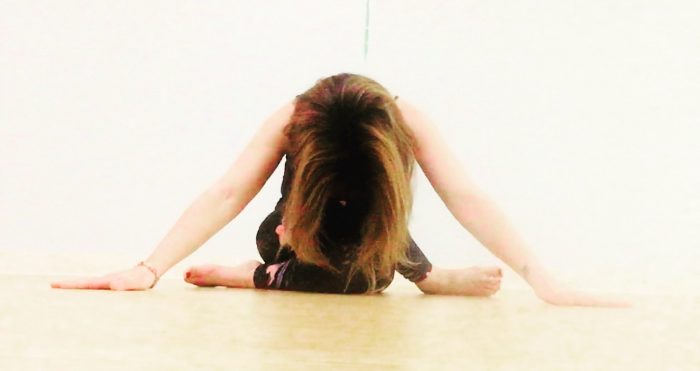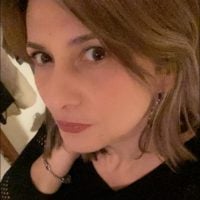Yin yoga was the practice that allowed me to find my voice.
It was a stepping stone toward giving myself permission to share my truth, my thoughts, and my feelings on topics that mattered to me.
At the ripe age of 41, I became a yoga teacher and I also found the courage to begin sharing my writing with an audience.
Yin yoga gave me confidence, it provided me with a medium, and it became a channel through which I could express myself, revealing the healing that comes from simply sharing our story. Because Yin focuses on stillness, and because it is the practice of allowing, surrendering, and releasing stuck energies and emotions, it is the perfect gateway to finally facing, accepting and embracing the dark side within.
What is Yin yoga?
Yin yoga is a style of yoga that is being taught in yoga studios all over the country, as it has gained much popularity in recent years. The short standard description will tell you that Yin yoga is a slower and more meditative practice, where we hold floor poses for three to five minutes to allow our body weight and gravity to lengthen the fascia, slowly moving bone away from bone.
Thus, with practice we become more agile and flexible in the joints. Most people who take the class for the “stretching” feel a physical need to be stretched—and that’s what gets them hooked initially. However, the pleasant side effects go much deeper.
Yin yoga affects the physical body, or annamaya kosha, which is our most outer layer–the skin, flesh, and bones—by creating space in the joints and by lengthening the connective tissues. It also affects our pranamaya kosha or energy body, by allowing the prana or chi to travel more freely through the body, thus balancing and healing our chakras, nadis, and meridians.
Next is our emotional body or manomaya kosha, and by making space in our physical bodies, we offer our stuck emotions a chance to be released and transformed. We can start to recognize the patterns in our thinking and how we experience emotions, and slowly but surely, some of our buried scars and wounds start resurfacing in order for us to finally face them and release them.
Over time, we become more and more comfortable in our own skin, and with practices like Yin yoga and meditation, we become more able to discern, witness, and connect with our higher mind, leading us to visit the wisdom body or vijnyanamaya kosha, with the possibility of one day making it to the bliss body or anandamaya kosha, where we are totally connected to our most whole and complete self.
The term Yin comes from the ancient Chinese philosophy of Taoism.
At the base of this theory are the principles of Yin and Yang, the two opposite forces that together make Tao, the one, the whole, the universe. There is no Yin without Yang and vice versa.
We recognize the dark only because we have experienced the light; things are defined a certain way only because of the way they relate to something else. The world is made of opposites, and everything is defined only in relation to its opposite, but it is together that they make the whole.
Dualism is necessary in order for us to understand the oneness of it all. Because I experience pain, I can recognize joy, and vice versa, but only because I am able to experience both I am fully human and one with the universe.
The ancient traditions are intertwined as we find the same principles in the Indian philosophy of Shiva and Shakti, the divine masculine and the divine feminine energies, consciousness and creation, the sun and the moon—all opposite forces that complement each other and that wouldn’t survive without each other.
And science is slowly catching up with this ancient wisdom with relativism and quantum physics, according to which, the observer creates the experience by the mere act of observing, thus making the other exist only in virtue of it being observed.
It all comes down to the fact that we are nothing but energy, and as such, we are separate and, simultaneously, one and the same.
When we apply this cosmic principle to our human experience, to our emotional turmoil, to our ability to cope with adversities, and to our inner dynamics, we come to terms with the fact that the moment we accept our human nature, is the moment we must let go of self-judgment. The moment we face our guilt, our shame, and our resistance to loving ourselves in all our humanness is the moment we are empowered to set ourselves free.
This theory shows up in our life as our identity.
Growing up is all about creating an identity: “I am this, not that.” We live in full dualism, in black and white. We choose what we need to wear, how we need to look, and how we must behave in order to get what we want—and usually, what we want is the approval and affection of a loved one, be it a parent, friend, or lover.
Inevitably, the journey takes us to a point where the side of us we have been saying no to, the side we’ve tried to hide and shove away under the carpet, resurfaces. Suddenly, the black and white lens no longer works, and we start seeing a lot of gray. We realize we are not all good or all bad. We are not ever only one thing and nobody and anything ever is. The time has come to explore the darkness.
It may be a painful process to come to terms with who we are in our fullness.
Seeing our shortcomings, difficulties, and struggles, we feel as if we are suddenly found out. The mask has fallen off, and we don’t know if we can bear the new face.
This is what coming of age is all about, this is what the journey of life comes down to—fully knowing and accepting who we truly are in all our humanness and messiness.
I first stumbled upon Yin yoga at an emotionally charged time of my life, right after having endured the ending of yet another short-lived relationship that confirmed my internal narratives of being unworthy and unlovable. It was in this mental and physical state of agony that I came across a workshop description that read, “Yin Yoga Training, Practicing Surrender & Receptivity, Diving Deeper into Subtle Terrain- Feelings, Beliefs & Transformation.” I had no idea what Yin yoga was, I was just intrigued by the “diving deeper” part.
I had completed my 200-hour teacher training two years prior, but had never taught a class, nor did I feel ready to ever ever face a class full of students. I later learned that the training I was attending was actually the second half of the program, part one having been about the anatomy and the history and principles of Yin yoga. These three days were all going to be about the emotional organ associations, the healing of the chakras, and the flow of life energy running smoothly through the meridians.
What a fantastic way to dive right into to the depth of this amazing practice at a time when I was an emotional mess!
Needless to say, I wept and wept during the training. Our amazing teacher, Corina Benner, read the most moving and beautiful poetry and spoke the truest and most thoughtful and emotion-provoking words, and I was hooked.
I later went back to take part one of the course and I have since been teaching Yin yoga several times a week at a number of studios. I am forever grateful for discovering this practice the way I did and discovering the teacher in me through it.
The darkness within me honors the darkness within you, because without it I couldn’t possibly get to appreciate and love our light. Namaste.












Read 0 comments and reply